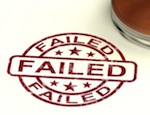7 Mistakes Doctors Make When Creating a Healthcare Brochure
Without giving it much thought, many--if not most--doctors will simply assume that they need a brochure to promote their medical practice. Often, this is true. But surprisingly often, it's a premature assumption where the "treatment gets ahead of the diagnosis."
A healthcare brochure is not always the first or most important component in a comprehensive marketing plan. Yet we often discover that a provider's office has dashed off to the nearest fast-print store to create a document that does little or nothing in the way of effective marketing.
In these instances, the largely-useless expense resulted from a long list of classic mistakes between concept to completion. Do your best to avoid these seven of the most common pitfalls that doctors make when creating a healthcare brochure.
1. Unclear (or wrong) objectives.
While most brochures are viewed as a "consumable expense," professional practice or organizational brochures should be designed with the clear and specific purpose of attracting new business, enhancing your practice reputation and bringing more revenue into the practice. A brochure that is simply "what we do" and "where we are" (an oversize business card) is not working hard enough to convince and attract.
What's more, a practice brochure is not the same as patient education. Patient education informs and educates, but healthcare practice brochures motivate people to become patients.
2. Trusting your brochure (and reputation) to the marketing "amateur hour."
Run-of-the-mill healthcare brochures are typically generic "templates," designed by entry-level designers at a printer. Worse, doctors and staff are usually saddled with the task of writing the brochure text (words). The trouble is, while lots of people can write a letter, few people (even in marketing) can write compelling words which motivate prospects to action.
Getting a prospective patient to pick up the phone and call you is a daunting task. To get the job done right, you will need at least three people working for you, the marketing strategist, a writer and a designer. Together, they will get the job done correctly.
3. Wrong size.
Brochures need to be large enough to deliver the message properly. In most instances, 8.5 x 11 bi-fold brochures are too small to present all that should be communicated.
On that note, it is a dangerous fallacy that "everything should fit on one page." Consumers want to skim and read what is important to them. Sometimes the message can be short, but more often you need more room to sell. The rule isn't to be short, it is to be exactly as long as necessary - no shorter or longer.
4. No heart.
People buy emotionally, and justify rationally. Put another way, your brochure must sell from the heart, not the head. This is something few people can create. More commonly they focus on the technology or the feature, but not the advantages or patient-critical benefits. Both the visuals and the words need to sell with emotion.
5. Look-a-like.
Healthcare practice brochures are often the cornerstone of your practice brand. They should tastefully (yet powerfully) differentiate your practice from the competition and uniquely answer "why you."
By definition, low-end brochures are generic, and done the same way for "everyone." It's the opposite of branding and differentiation, and says nothing to reinforce your professional reputation.
6. Wrong words.
Your text--the written word--must be active voice and directive. It should have a call to action and a sense of urgency. It needs to be conversational and flow. The prospective patient does not care about you organizational rules. (This is no place for "riot act" instructions about cancellations, late arrivals or completing insurance forms.) If it's not fostering a relationship and inspiring action, it probably does not belong in a brochure.
7. Beautiful failures.
Pretty is nice, but that's not nearly enough. Good eye-flow and readability are essential in a brochure. Photos and illustrations must be perfect. Colors must motivate and append your message. Oftentimes, graphic artists focus solely on making something "visually perfect." But pretty poison can kill when appearance overshadows the larger objective of winning new business.
An effective marketing brochure will be primary tool in your overall plan. It will be a brand-consistent brochure that attracts patients, differentiates you and enhances your reputation. And your ROI? You'll get your investment back with a few good cases.









